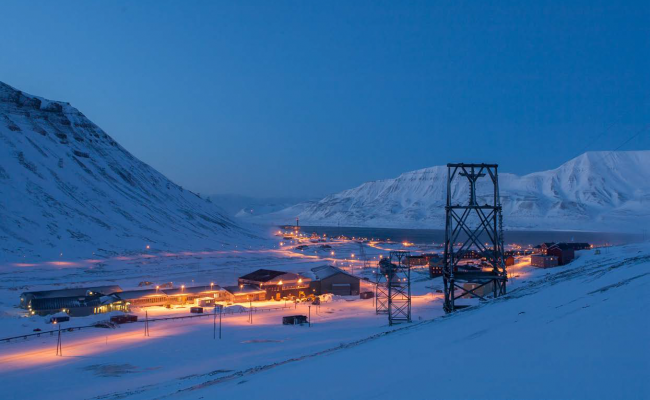The Svalbard Treaty: A Viable 100-Year-Old or One Foot in the Grave?
The State Secretary for the Ministry of Justice, Kristin Kallset (Labor), and Minister of Justice, Astri Aas-Hansen (Labor), hosted the commemoration of the 100th anniversary of the Svalbard Treaty. (Photo: Trine Jonassen)
Oslo (High North News): This year, 100 years have passed since Svalbard became part of Norway. But the celebrant is still highly relevant, and PM Jonas Gahr Støre says the High North was one of the topics discussed during his recent visit with US President Donald Trump.
Cold winds tear through the capital's streets and equalize the warmth of the spring sun, as if to make it a bit more homey for the travellers from the North on this Wednesday in May.
It marks 100 years since the Svalbard Treaty came into force, and Svalbard became a part of the Kingdom of Norway.
Inside the warm old Oslo lodge, a historical building by the Akershus Fortress, lively and loud buzzing sounds emerge. Warm handshakes and hugs are shared with "Long time, no see".
Although most of the country is north, that is where the fewest people live. And the cliche that "if you live in the North, I suppose you know...?" is not entirely false.
Top-heavy celebration
The Ministry of Justice, which organized the event, has truly gone all out and invited both the royal and crown prince couples and the Prime Minister and the Minister of Justice and Public Security.
There is also a celebratory festschrift in honor of the celebrant when the day is marked on Svalbard Day in Longyearbyen on August 14th.
There is something symbolic about the visit by the famous, even though the royal guests and the prime minister left after the first part of the day. Svalbard means a lot to Norway.
The Norwegian High North was also a topic when Prime Minister Jonas Gahr Støre (Labor) recently visited the United States and President Donald Trump (R) in the White House.
"He asked what rules actually apply in the north. I replied that rules absolutely apply in the north, yes," says the prime minister, slightly laughing.
As funny and a little absurd as it may sound, there is a seriousness behind it.
Terra nullius
Historically and legally, the treaty contributed to a uniquely early and rapid clarification of sovereignty over an Arctic territory long perceived as a terra nullius.
"In other words, a place where rules do not apply," says Støre.
Statsminister Jonas Gahr Støre (Ap) deltok på markeringen av Svalbardtraktatens 100-årsjubileum i Oslo. – Arktisk geopolitikk og ivaretakelse av regler og spilleregler i nord er på Regjeringens dagsorden flere ganger hver uke, sier Støre. (Foto: Trine Jonassen)
"When I say a long time, I am talking about right up to our time. I have met many decision-makers who one could assume had a high level of knowledge, but who have also thought that up there in the Arctic, the existing regulations do not really apply," says the Prime Minister.
"And it is partly in the American president's question about which rules apply in the north, a sentence rarely uttered: "Or do any rules apply there"? It is crucial to say that the law of the sea, international law, and the rights and obligations of coastal states apply. It is not a lawless region."
Undisputed sovereignty
The Prime Minister points out that all representatives of Norway must have this in mind when meeting with other nations. They must talk about Svalbard as Norway's northernmost part of the country, just as Østfold on the mainland is part of southeastern Norway.
"We must reiterate that we have full and undisputed sovereignty over Svalbard and the exclusive right to exercise authority over the archipelago in line with principles of international law."
On August 14, 1925, the Norwegian flag was raised in Longyearbyen on a flagpole manufactured by the company Store norske Spitsbergen kullkompani. Svalbard was officially part of the Kingdom of Norway, and 100 years of undisputed and uninterrupted sovereignty over the archipelago began.
Also read (the article continues below)
The end of the coal mine
1 ½ months before the official 100th anniversary celebration in Longyearbyen, Store norske is closing down the last coal mine in Norway, Mine 7. There is no more coal in the mine, and it is time for Longyearbyen, which is named after the American Arctic Coal Co. founder John Munroe Longyear, also to enter the green shift with solutions for renewable energy
The Svalbard Treaty is divided into articles. Article 3 deals with the treaty's principle of equality:
"The nationals of all the High Contracting Parties shall have equal liberty of access and entry for any reason or object whatever to the waters, fjords and ports of the territories specified in Article 1; subject to the observance of local laws and regulations, they may carry on there without impediment all maritime, industrial, mining and commercial operations on a footing of absolute equality."
Freely?
In today's heated geopolitical climate, with Trump threatening to take over both Greenland and Canada, Russia's aggression against neighboring countries, and China hanging over everything like a wildcard in the north, it is timely to ask whether the Norwegian authorities have as good control over Svalbard as they claim.
Although there is no more coal in Norway's last coal mine, there is still coal in Svalbard. For example, can China, which already has its own research station in Svalbard, start mining operations under the principle of equality?
"No," says Minister of Justice Astri Aas-Hansen (Labor).
Requires permission
She reminds us that Store norske has decided to close down the mining operation, a decision supported by the parliament and the government. The justification is that there is no longer a basis for further operation. Mine 7 is empty.
"It is possible to start up elsewhere, but it requires permission from the Norwegian authorities. So even if someone has a mining permit, they do not have the right to start. It is the Norwegian authorities who decide," Aas-Hansen explains to High North News.
Were the new, strict changes to the Svalbard Environmental Act adopted with this as a political backdrop? In other words, to make it more difficult for other nations to start commercial activities such as mining?
"We have obligations related to the climate and environment to continue safeguarding the special nature, bird, and plant life. We therefore have strict regulation through the Svalbard Environmental Act and thus strict regulation of all activity on Svalbard," says Aas-Hansen.
The King and Queen attended parts of the commemoration of the 100th anniversary of the Svalbard Treaty, together with the Crown Prince and Princess. The royals were escorted out by Minister of Justice Astri Aas-Hansen (Labor), with King Harald at the front. (Photo: Trine Jonassen)
She adds that this applies equally to everyone who stays or has activities on Svalbard, regardless of nationality. It also means stricter regulations for research.
The law applies to all citizens of Svalbard.
At the same time that Svalbard became Norwegian, the Norwegian authorities changed its name. When the Svalbard Treaty was signed in 1920, it was called the "Spitsbergen Treaty" for short, named after a Dutch expedition led by Willem Barentsz who discovered the country in 1596.
Renewed
Spitsbergen means steep mountains. It was long believed that this new country was part of Greenland.
"The name was not only to be Norwegianized, but also to be renewed in the Norwegian language, explains historian Thor Bjørn Arlov.
Also read (the article continues below)
Equal in the eyes of the law
A separate naming committee was established in 1924, which proposed renaming Spitsbergen to Svalbard.
"It could be seen as a form of cultural imperialism, but in this case, it was about creating a map that would form the basis for the property system," explains Arlov.
The period from the treaty being signed in 1920 until coming into force five years later, Arlov describes as a Norwegianization process where a mining system, laws and administrative systems were established, securing Norwegian economic interests, clearing up property claims and, not least, obtaining recognition from Germany and Soviet Russia, which were not represented in the negotiations.
Using the old name
The Soviet Union acceded to the agreement ten years later, in 1935.
On the occasion of the anniversary year, Russia's ambassador to Norway, Nikolay Korchunov, says in an interview with the state-owned news agency TASS that Russia supports the content of the Svalbard Treaty and that all parties, including Norway, "fulfill in good faith their international legal obligations stipulated in the treaty."
No one calls St. Petersburg Leningrad anymore.
Korchunov emphasizes that Russia desires constructive cooperation with the Norwegian authorities in accordance with the terms of the Svalbard Treaty and to preserve Svalbard as a low-tension zone in the Arctic.
However, the ambassador also made sure to mention that Russia was concerned about "attempts to draw the archipelago into military preparations by Norway and its NATO allies."
The island of Spitsbergen
Historian Arlov points out that Russia usually uses Spitsbergen for Svalbard, even though the archipelago changed its name 100 years ago.
"100 years ago, Christiania changed its name to Oslo, and Spitsbergen to Svalbard. No one calls St. Petersburg Leningrad anymore," says Arlov.
The Russian embassy writes Svalbard in its Facebook post, but in the original interview in Russian, it is still called Spitsbergen. Today, there is only one island called Spitsbergen, where the entire population of Svalbard lives, both Russian and Norwegian.
"We are the world's smallest union," joked one of Svalbard's former governors, Kjerstin Askholt. From left: Lars Fause, Kjerstin Askholt, Sven Ole Fagernæs, Ann-Kristin Olsen, Per Sefland, Morten Ruud, and Editor-in-Chief and conference organizer for the event, Line Nagell Ylvisåker. (Photo: Trine Jonassen)
One for all
The Russian ambassador refers to Article 9 of the Svalbard Treaty, which prohibits military bases and fortifications, and the use of Svalbard for war purposes in peacetime. According to historian Arlov, prohibiting bases for war purposes was not unusual when the treaty was written and must be seen in the light of World War I.
Prime Minister Støre confirms that Norway adheres to the provisions of Article 9, but at the same time assures that NATO's security guarantees apply to the Norwegian archipelago to the highest degree, despite repeated assumptions to the contrary.
"NATO's Article 5 applies to Svalbard. Svalbard is Norway and Norway is NATO," Støre states.
Article 5 of the Atlantic Treaty states that an armed attack against one or more of the member states shall be considered an attack against them all and trigger collective defense.
However, the prime minister does not seem worried and still believes in low tension in the north.
Also read (the article continues below)
"I think it is in the interest of the Russians to. Russia's strategic weapons are located ten miles from the Norwegian border, and it is in Russia's interest to avoid turbulence so close to its own border."
A man's land
When mining was established on Svalbard, it was a society designed for men. Female citizens were not to be had, and the medical profession of the time advised against having native children because they could "degenerate in the harsh climate and darkness".
That says a bit about how the people of the far north were viewed then.
"They probably didn't imagine, when they raised the flag, that the land without people would have an urban society on a par with other cities. It is an achievement that we have a family society and our own local government in the Arctic Circle, where we otherwise only find military bases and the occasional hunting community," says Terje Aunevik (Liberal), who is the head of the Longyearbyen local government.
The Svalbard Treaty
The Svalbard Treaty, also known as the Paris Treaty, was signed on February 9th, 1920, in Paris by several countries concerning the archipelago of Svalbard.
It was signed in connection with the peace conferences after World War I.
It was not until 1925 that the treaty's provisions on Norwegian sovereignty over the archipelago were established in Norwegian law through the Svalbard Act, which regulates Norway's exercise of sovereignty and authority in Svalbard.
The treaty establishes "Norway's full and unrestricted sovereignty over the Svalbard archipelago".
The agreement grants Norway sovereignty over Svalbard; Spitsbergen and the surrounding islands, Bjørnøya, and Hopen.
The parties to the treaty nevertheless have "equal rights to fishing and hunting" in these areas and in their territorial waters.
Arctic superpower
He believes that this family community is particularly important in the turbulent times we live in.
Aunevik emphasizes that there has never been a conflict over Svalbard, which "peacefully and steadily lies in the middle of an international hotspot in the most Arctic place there is".
"Svalbard makes Norway an Arctic superpower. The Svalbard Act provides security and stability, and we can proudly say 'raise the flag'!"
Misunderstandings
Superpower or not. There are several misunderstandings about which rights and limitations actually apply in Svalbard.
Researcher at the High North Center and the Fridtjof Nansen Institute, Andreas Østhagen, advocates for a stronger political discussion regarding Norway's sovereignty over Svalbard.
Also read (the article continues below)
"We need to talk openly about Svalbard. Norwegian authorities must inform about Norwegian sovereignty. There is a need for knowledge out there, and a small battle over the narrative in the North. Russia has its own narrative about the law of the sea and Svalbard, and we must come up with a response and present maps of the Norwegian areas," says Østhagen.
Unclear edges
The Prime Minister agrees that the High North can appear somewhat unclear around the edges to others, even to our allies in NATO. During the debate, Støre talked about his meetings with maps and overviews of NATO's areas of responsibility, where it is "a little unclear around the edges".
"In such cases, it is our job to inform that this must be filled in correctly," states Jonas Gahr Støre before he heads out into the unusually cold Oslo wind.
Inside Oslo's old lodge, "the world's smallest trade union", as former governor Kjerstin Askholt calls it, is sitting on stage. Six governors, two of whom are women, are gathered to share, reminisce, and conclude the official part of an eventful day.
The right man
The governor of Svalbard is the Norwegian government's highest representative on the Svalbard archipelago, with the same authority as a county governor. The governor is also the police chief and notary public, in addition to other public functions.
There was a lot of criticism.
The six tell stories about the first female governor from 1995 to 1998, Ann-Kristin Olsen (80), who had to deal with the tragic plane crash on Operafjellet in 1996, where 141 Russian and Ukrainian citizens lost their lives. Olsen describes the time afterwards in the small local community as difficult.
The memories are still vivid.
The Arctic man
Morten Ruud (90), governor from 1998 to 2001, tells of being unwanted as governor in the mining community. There was a lot of criticism to be had as the Norwegian state's man in Svalbard.
Kjerstin Askholt (63), governor from 2015 to 2021, shares her experience as a new governor when an avalanche took two lives and completely damaged 11 houses in Longyearbyen just two months after Askholt had started the job.
"It was good to feel that we were resourceful regarding human life. We had a large and robust team behind us in our ministry. We managed to cooperate, Store norske, the governor, and the Red Cross," she says.
The Governor of Svalbard, Lars Fause, with the Director of the Norwegian Polar Institute, Camilla Brekke, in Oslo's Old Lodge to mark the 100th anniversary of the Svalbard Treaty entering into force. (Photo: Trine Jonassen)
At the mercy of nature
She adds that nature affects the people of Svalbard, whether they want it or not.
"It is beautiful and merciless and brings people together because we are so small. It is a unique small town that, across cultures, has a unique and strong unity. It has shaped me as a person," concludes Kjerstin Askholt.
Lars Fause says the legacy of the governors is still in the walls.
"But it is much quieter now, more bureaucracy," says Fause, who believes Svalbard will become even more important in the future.
Vital 100-year-old
A lot has changed in 100 years, from terra nullius to bureaucracy.
I ask Minister of Justice Astri Aas-Hansen whether the Svalbard Treaty is a vital centenarian or has one foot in the grave?
The ministry chooses not to answer that.
So, no need for renewal?
"What we are celebrating today is the incorporation of Svalbard into the Kingdom of Norway, and the basis is the treaty. However, sovereignty rests on other things, such as 100 years of undisputed sovereignty. The treaty is not something that is brought up for renegotiation or discussion. It is there," Aas-Hansen asserts.





